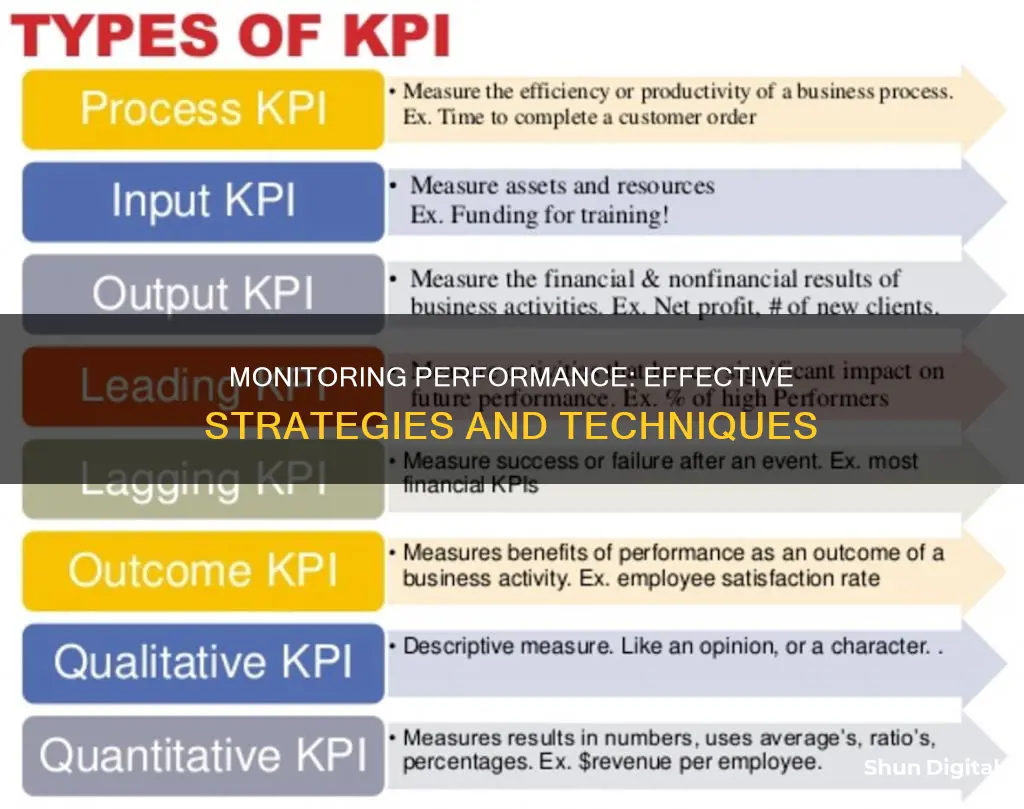
Performance monitoring is a critical aspect of management that involves measuring, evaluating, and enhancing performance at both the individual and corporate levels. It is essential for organisations to stay ahead of the competition and achieve success. While there are various methods for monitoring performance, such as Key Performance Indicators (KPIs) and performance appraisals, it is important to establish a routine of regular check-ins and utilise effective project management tools. This can include direct observation, task management software, selective control, and performance management frameworks like the Balanced Scorecard (BSC). Additionally, employee monitoring software can track computer activity, but it is important to consider the ethical implications and potential impact on morale. Ultimately, by investing in performance management tools and techniques, businesses can foster a culture of high performance and improve productivity and employee satisfaction.
| Characteristics | Values |
|---|---|
| Purpose | To observe and analyse performance, identifying deviations from normal behaviour and potential issues |
| Scope | Monitoring can be applied to individuals, teams, systems, applications, and the overall organisation |
| Frequency | Regular, constant, or real-time monitoring is ideal to keep track of performance |
| Data Sources | Performance metrics, trends, patterns, KPIs, peer reviews, self-reported surveys, etc. |
| Tools | Performance/employee monitoring software, task management software, performance counters, profilers, etc. |
| Benefits | Data-driven decision-making, risk management, improved efficiency, employee well-being, legal compliance, etc. |
| Limitations | Privacy and security concerns, employee resistance due to fear of micromanagement |
What You'll Learn

Performance monitoring software
Performance monitoring is a crucial aspect of managing employees and driving business success. It involves observing and evaluating how individuals or teams perform their tasks within an organisation. Performance management software is an essential tool in this process, offering centralised systems with data-backed insights to streamline the performance monitoring process.
Performance management software provides a systematic approach to setting goals, tracking progress, and monitoring employee performance. These software solutions automate routine tasks such as performance reviews and feedback documentation, freeing up time for managers and HR professionals. They enable organisations to establish clear goals and expectations, use relevant key performance indicators (KPIs), and provide regular feedback to employees.
One example of performance management software is iMonitor EAM, which offers total employee monitoring solutions for enterprises of all sizes. It records various employee computer activities, including keystrokes, clipboard activities, screenshots, and file documents.
Another popular feature of performance management software is activity monitoring, which allows real-time insights into employee productivity and potential distractions. This information can be used to improve overall efficiency and address issues impacting productivity.
When choosing performance management software, it is essential to consider the specific needs of the organisation and the type of work performed by employees. Additionally, finding a platform that maintains employee privacy while providing valuable monitoring insights is crucial.
By leveraging performance management software, organisations can effectively monitor employee performance, identify areas for improvement, and make data-driven decisions to optimise productivity and achieve their goals.
Efficiently Removing User "Bossman" Monitors: A Step-by-Step Guide
You may want to see also

Employee monitoring software
- Monitask: This software allows you to monitor how much time employees spend on productive tasks and specific websites and applications. It also includes task and project management capabilities and a screen capture feature that takes random screenshots.
- Insightful: This software provides a summary of employees' productive and unproductive time, along with apps and website monitoring. It also has a stealth mode that lets you investigate suspicious activities.
- Connecteam: Connecteam is designed specifically for managing a remote workforce. It includes features such as real-time time tracking, an absence management feature, and communication tools.
- Intelogos: This AI-driven software monitors employee activity and provides insights to improve productivity and prevent burnout. It prioritises privacy and transparency and does not include keystroke logging or video recording.
- Veriato: Veriato offers a user-friendly interface and a range of features, including activity logging, screenshot capturing, keystroke logging, and web activity monitoring. It also has an AI-powered intelligent alert system that can identify unusual behaviour patterns.
- Clockify: Clockify has a calendar feature for monitoring employee activities and timesheet monitoring functionalities. It also offers an intuitive dashboard for leaders to track project completion.
- CleverControl: This cloud-based software includes features such as screen recording, webcam recording, and call recording, making it suitable for organisations with frequent meetings involving sensitive information.
- TimeDoctor: TimeDoctor is a suite of time-tracking tools with features such as real-time alerts, online timesheets, and payroll integration. It works on various devices, including Windows, Mac, Linux, iOS, and Android.
- ControlUp: ControlUp is a digital employee experience management system that helps monitor and optimise employee experience by collecting and storing historical data of device performance.
- Hubstaff: Hubstaff offers time tracking, employee monitoring, and project management features. It includes GPS tracking, activity monitoring, and productivity analysis for remote teams.
- Teramind: Teramind provides comprehensive tracking functionality, capturing user activity such as screen recordings, live views of employee PCs, tracking emails, keystrokes, and Zoom sessions.
- ActivTrak: ActivTrak is cloud-based software that tracks employees' behaviour, productivity, efficiency, workload balance, and goals. It integrates with Google Workspace to embed employee work activity metrics.
- BambooHR EMS: BambooHR is cloud-based HR software with features such as 360 feedback, peer feedback, assessment templates, and custom review cycles. It also includes essential HR management tools like employee record organisation, benefits tracking, and document storage.
- SentryPC: SentryPC offers various licensing plans and real-time monitoring capabilities. It allows for keystroke tracking and provides essential monitoring features, such as content filtering and blocking.
These software tools provide businesses with insights into employee behaviour, productivity, and performance, helping to improve efficiency, ensure compliance, and protect sensitive information.
Detecting Keystroke Monitoring: What to Look For
You may want to see also

Peer reviews and 360-degree feedback
Performance monitoring is a crucial aspect of maintaining a competitive edge in today's fast-paced business landscape. It involves regularly observing and evaluating how individuals or teams perform their tasks within an organisation, ensuring that operations run smoothly and facilitating timely interventions to maintain productivity. One effective method of monitoring performance is through peer reviews and 360-degree feedback, which offer a holistic view of an employee's strengths and areas for improvement.
Understanding 360-Degree Feedback
360-degree feedback is a process where employees receive confidential, anonymous evaluations from their colleagues, including managers, peers, and direct reports. This method provides a comprehensive insight into an employee's performance by incorporating feedback from multiple perspectives. The feedback usually covers a broad range of workplace competencies and includes both quantitative ratings and qualitative written comments.
Benefits of 360-Degree Feedback
360-degree feedback offers several advantages. Firstly, it promotes self-awareness among employees, giving them a clear picture of their strengths and weaknesses. Secondly, it enhances professional growth by providing a benchmark for skill development and helping employees identify opportunities for improvement. Thirdly, it aids in personal development by revealing blind spots in behaviour and the impact they may have on others. Additionally, 360-degree feedback improves communication and teamwork, as employees gain a better understanding of how their work fits into the organisation.
Implementing 360-Degree Feedback
When implementing 360-degree feedback, it is important to ensure anonymity and confidentiality to encourage honest and unbiased evaluations. The feedback process should be well-structured and communicated clearly to all participants, with defined goals and expectations. To gain the most valuable insights, a mix of eight to twelve people from different levels and roles within the organisation should be involved in providing feedback.
Peer Reviews as Part of 360-Degree Feedback
Peer reviews are an integral part of 360-degree feedback, where colleagues provide feedback on a fellow employee's job performance. This can include peers, supervisors, subordinates, and even external raters such as clients or vendors. By involving a diverse range of reviewers, organisations can gain a well-rounded understanding of an employee's performance and its impact on the broader organisation.
Benefits of Peer Reviews
Peer reviews offer several advantages. Firstly, they provide a unique perspective on an individual's skills, competencies, and personal temperament. Secondly, they help identify areas for professional growth and skill development, allowing employees to set development goals. Additionally, peer reviews can improve customer service by providing feedback on the quality of an employee's product or service. They also promote accountability and a sense of ownership among team members.
Challenges and Considerations
While 360-degree feedback and peer reviews can be highly beneficial, there are some challenges to consider. One potential issue is the reliability of data, as different reviewers may have varying interpretations of performance or behaviour. Additionally, the process may require additional time and resources for planning and implementation. Furthermore, there is a risk of creating a negative culture if the focus is primarily on employee weaknesses rather than strengths.
Best Practices
To maximise the effectiveness of 360-degree feedback and peer reviews, it is recommended to repeat the process every one to two years, allowing employees to work through their development plans and make meaningful changes. Additionally, it is crucial to separate these reviews from employee evaluations and performance reviews to create a safe space for honest feedback. Organisations should also provide support and guidance to employees post-review, helping them develop action plans based on the feedback received.
In conclusion, peer reviews and 360-degree feedback are valuable tools for monitoring performance, providing a holistic view of employee strengths and areas for improvement. When implemented effectively, these methods can drive professional growth, enhance self-awareness, and improve overall organisational performance.
Monitoring IBM Content Navigator Performance: Strategies for Success
You may want to see also

Self-reported surveys
However, there are limitations to self-reported surveys, especially if they are not conducted anonymously. Employees may censor themselves to appear more favourable or compliant, or they may fear repercussions for expressing negative opinions. To mitigate this, surveys should be carefully designed and worded to encourage honest responses. They should also be supported by objective data to provide a more comprehensive understanding of employee performance.
However, there are some limitations to self-reported surveys. One concern is that employees may not feel comfortable providing honest feedback, especially if the surveys are not anonymous. They may censor their responses to present themselves in a more positive or compliant light, or they may fear repercussions for expressing negative opinions. Additionally, without objective data to support their responses, employees may struggle to provide meaningful insights or discussion points.
To address these limitations, it is crucial to design and word surveys carefully. They should be professionally scripted to elicit honest and thoughtful responses while ensuring anonymity and confidentiality. This approach will encourage employees to share their genuine thoughts and concerns without fear of consequences. Additionally, combining self-reported surveys with other performance monitoring methods, such as regular check-ins and performance reviews, can provide a more comprehensive understanding of employee performance and engagement.
In conclusion, self-reported surveys can be a powerful tool for monitoring employee performance and improving engagement and satisfaction. They provide a direct line of communication between employees and management, allowing employees to express their thoughts and feelings. However, to overcome limitations and encourage honest feedback, surveys should be carefully designed and supported by objective data. When used in conjunction with other performance monitoring methods, self-reported surveys can contribute to a holistic understanding of employee performance and a positive work environment.
Hong Kong Monitor Shopping: Where to Buy?
You may want to see also

Regular check-ins and one-on-one meetings
When scheduling regular check-ins and one-on-one meetings, it is important to create a safe and open space for employees to express their thoughts and concerns. This can be achieved by encouraging open and honest communication, actively listening to employees, and providing reassurance that any information shared will remain confidential.
During these meetings, managers can inquire about employees' well-being, workload, and job satisfaction. It is also a good opportunity to review and reset goals, discuss expectations, and offer support or additional resources if needed.
To make the most of regular check-ins and one-on-one meetings for performance monitoring, managers can:
- Schedule meetings at regular intervals, such as weekly, bi-weekly, or monthly, to ensure consistent progress reviews and provide ongoing support.
- Prepare an agenda beforehand to structure the meeting and ensure all important topics are covered.
- Create a safe and non-judgmental space for employees to express their thoughts and concerns openly and honestly.
- Discuss progress towards goals and expectations, reviewing any milestones achieved since the last meeting.
- Identify any challenges or roadblocks the employee is facing and collaborate on finding solutions.
- Offer feedback and guidance to address areas of improvement and reinforce positive performance.
- Recognize and reward employees for their achievements, celebrating their successes.
- Reset and revise goals as needed, ensuring they remain achievable and aligned with the employee's capabilities and the organization's objectives.
- Provide opportunities for employees to offer feedback on their role, responsibilities, and the organization as a whole.
- Inquire about the employee's well-being and job satisfaction to ensure they feel supported and engaged in their work.
By conducting regular check-ins and one-on-one meetings, managers can effectively monitor employee performance, address concerns promptly, and provide the necessary support and guidance to help employees thrive in their roles.
Designo Monitors: ASUS's Premium Display Lineup Explored
You may want to see also







